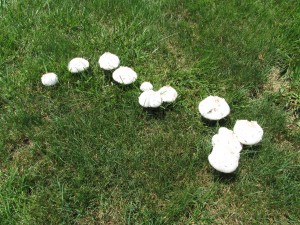White or brown colored mushrooms are the visible reproductive (fruiting) structures of some types of fungi. An umbrella-shaped fruiting body is the most common form, but mushrooms come in many shapes, sizes, and colors. Most people call them mushrooms, toadstools, or puffballs. Mushrooms are the reproductive stage of fungi and their spores are “seed”, the next generation. Their key objective is to produce and release spores.
Most fungi in lawns are beneficial. Fungi serve as nature’s decomposers, feeding off the soil’s organic matter and releasing nutrients that become available to plant roots. Many fungi, including those that cause lawn diseases, produce small fruiting bodies that are scarcely noticeable. They’re not the typical mushrooms that panic most homeowners.
Microscopic fungal spores are carried by wind and water to new areas. When spores reach a favorable place, they germinate (like seeds), sending out long thin filaments called “hyphae”. These hyphae form a network of mycelium that decomposes wood, fallen leaves, mulch, dead insect and worms, etc. The organic matter serves as food for the fungi.
Mushrooms are produced when weather and soil conditions are optimal. Fungal mycelium generally survive in the soil many years. Picking and/or raking up mushrooms doesn’t kill the underground mycelium from which they are growing. Rapid removal may prevent their spores from spreading to new sites. Likewise, the spores from neighboring properties may come to your lawn. Removing mushrooms from lawns principally serve to keep them away from children and pets and to improve a lawn’s appearance.
Finally, unless an accurate lawn disease diagnosis has been made, blind applications of fungicides to “kill mushrooms” is often a wasteful and costly practice. Observing mushrooms growing on the ground is a natural phenomena.


 Posted in
Posted in 
